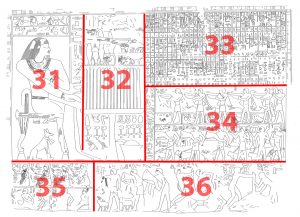
Almost the whole surface of the wall is occupied by a representation of the vizier receiving offerings, supposedly brought by his relatives, to grant an enjoyable afterlife for their venerable forefather. To the left, he sits in a chair with legs in the shape of lion paws (31); under the chair, his favourite dog, named Iru-em-shetj (which means „One-who-is-shaped-as-honey-badger“), keeps guard. The table placed in front of the vizier is richly laid with tall and narrow bread halves (32), and a pile of fruit, vegetables and meat is stacked above it. Placed under the table, is a jag with a bowl for ablutions.
Ancient Egyptians were greatly proficient in preparing various lists, registers and reports; all goods that the deceased was supposed to receive have been listed in the form of a table, filling the right upper part of the wall (33); in the subsequent rows, items and their quantity (with the measurements units such as jars, cups, pieces etc.) are listed.
Below the offering list, two rows of offering bearers carry poultry and meat for the spirit of the late dignitary (34).
In the left part of the lowermost register and directly under the large figure of the vizier, a group of eight persons keep him amused (35): four women, who turn out to be the vizier’s wives, and four male singers.
The right and middle parts of this register comprise a butchery scene, showing two pairs of butchers at work and three servants carrying away prepared meat portions (36). Short inscriptions above the figures contain their conversations: “Finish with this leg!“ “Take it; hurry up, comrade!“
